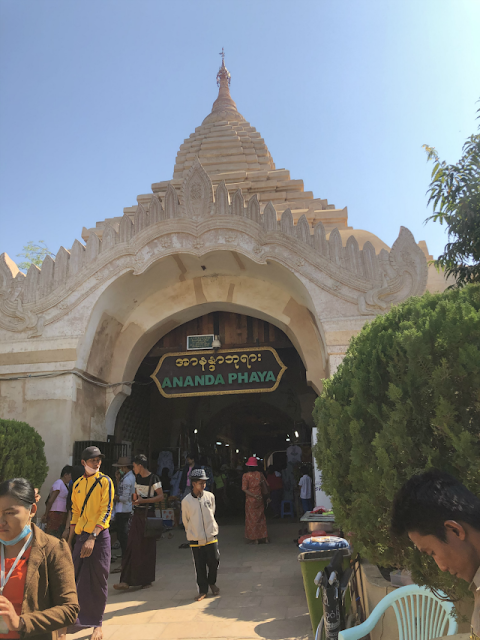Dhammayazika Pagoda is situated in Pwazaw village in south-east of old Bagan.
Most of the pagodas in Bagan have square terraces with four entrances but Dhammayazika differs from other pagoda in having a pentagonal terrace design with five Buddha images at five entrances.
We usually see pagoda and temples with four entrances and four Buddha images on the entrances. But, here we have five entrances around the stupa.
History of pagoda:
Dhammayazika was built by King Narpatisithu in 1196. The inscription records say that the King had recieved holy relics of Buddha from Sri Lanka which he wanted to enshrine. Holy relics are enshrined in the temple here.
Dhammayazika translates to "Pertaining the King of Law"
It is surrounded by small temples in which reside the images of Buddha.
The gilded stupa has concentric rings. There are kaal mukha(ogre heads) connected by a garland. On top of it is the bell shaped dome with a beautiful decorated belt, lotus buds on top of it. The hti or the umbrella was missing when I visited the place.
The base of stupa is decorated with Jataka terra-cotta plaques. Many of them have been damaged.

Most of the pagodas in Bagan have square terraces with four entrances but Dhammayazika differs from other pagoda in having a pentagonal terrace design with five Buddha images at five entrances.
We usually see pagoda and temples with four entrances and four Buddha images on the entrances. But, here we have five entrances around the stupa.
entrance to temple on east
History of pagoda:
Dhammayazika was built by King Narpatisithu in 1196. The inscription records say that the King had recieved holy relics of Buddha from Sri Lanka which he wanted to enshrine. Holy relics are enshrined in the temple here.
Dhammayazika translates to "Pertaining the King of Law"
What's so special of this pagoda?
This is one of the pagodas in Bagan with five entrances with Buddha images on all sides.
The fifth entrance is for the future Buddha, Maitreya, who will reach Nirvana as well.
It is the biggest pentagonal pagoda in Bagan region.
pillar with dharamchakra on top near the entrance to pagoda
one entrance to the five-sided temple
pagoda with pillar on its side
The pagoda is a brick structure topped by a large bell shaped gilded stupa.It is surrounded by small temples in which reside the images of Buddha.
Fresco on ceiling
fresco and stucco work at entrance
golden Buddha inside the pagoda, guardians on either side of east entrance
Bagan style Buddha
Buddha, on another entrance
close-up
another image
The receding terraces have golden stupas on its corners.The gilded stupa has concentric rings. There are kaal mukha(ogre heads) connected by a garland. On top of it is the bell shaped dome with a beautiful decorated belt, lotus buds on top of it. The hti or the umbrella was missing when I visited the place.
The base of stupa is decorated with Jataka terra-cotta plaques. Many of them have been damaged.
plaques at base
The plaques portray tales from Jataka
All around on the five sides of stupa are shrines which have a shikhara topped by a gilded hti. Each shrine houses an image of Buddha.
There are chinthes on top of temple and gilded stupa with hti on receding terrace
guardian on top of temple

stucco work on pillar
receding terraces of pagoda and golden pot with gold leaves
ceremonial bell at one corner of pagoda
Thitsarwadi temple, far behind and an unknown temple
a shrine in a corner
I was not able to find the reason for so many pairs of shoes in a corner of the shrine.Dhammayazika Stupa is said to be best example of Bagan architecture and one of the must visit stupa in Bagan.












































































